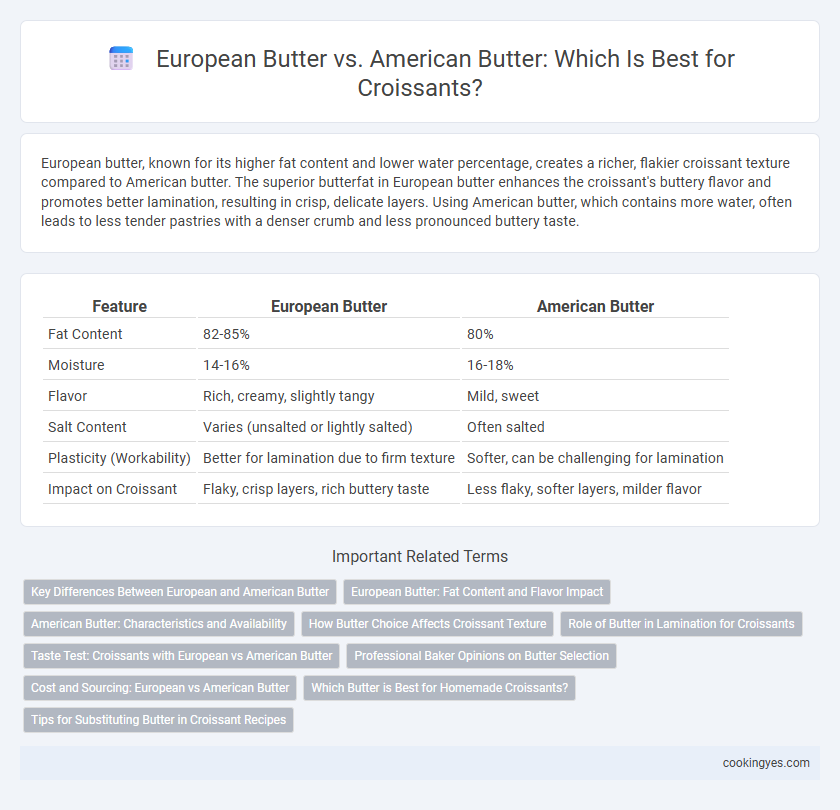European butter, known for its higher fat content and lower water percentage, creates a richer, flakier croissant texture compared to American butter. The superior butterfat in European butter enhances the croissant's buttery flavor and promotes better lamination, resulting in crisp, delicate layers. Using American butter, which contains more water, often leads to less tender pastries with a denser crumb and less pronounced buttery taste.
Table of Comparison
| Feature | European Butter | American Butter |
|---|---|---|
| Fat Content | 82-85% | 80% |
| Moisture | 14-16% | 16-18% |
| Flavor | Rich, creamy, slightly tangy | Mild, sweet |
| Salt Content | Varies (unsalted or lightly salted) | Often salted |
| Plasticity (Workability) | Better for lamination due to firm texture | Softer, can be challenging for lamination |
| Impact on Croissant | Flaky, crisp layers, rich buttery taste | Less flaky, softer layers, milder flavor |
Key Differences Between European and American Butter
European butter used in croissants contains a higher fat content, typically around 82-85%, compared to American butter's 80%. This increased fat percentage contributes to a flakier, richer texture and more pronounced buttery flavor in the final croissant. European butter also offers a tangier taste due to traditional cultures and longer fermentation, enhancing the pastry's complexity.
European Butter: Fat Content and Flavor Impact
European butter typically contains 82-85% fat, higher than American butter's average of 80%, which contributes to a richer, flakier croissant texture. The increased fat content in European butter enhances the dough's lamination process, resulting in distinct, crispy layers and a more buttery flavor profile. This higher fat ratio also influences moisture retention and browning, crucial for achieving the traditional golden crust of authentic croissants.
American Butter: Characteristics and Availability
American butter, often higher in moisture content compared to European butter, can affect the flakiness and texture of croissants by producing a softer, less crisp pastry. Typically available nationwide in various fat contents, American butter is easier to source and offers consistent quality for home bakers seeking convenience. Brands such as Land O'Lakes and Kerrygold provide options that balance flavor and spreadability, making them popular choices in croissant recipes across the United States.
How Butter Choice Affects Croissant Texture
European butter, with its higher fat content (around 82-86%) and lower moisture, creates a flakier and richer croissant texture compared to American butter, which typically contains 80% fat and more water. The reduced moisture in European butter allows for better lamination, producing distinct, crisp layers in the dough. Using American butter may result in a softer croissant with less pronounced layering due to its higher water content disrupting the dough's structure during baking.
Role of Butter in Lamination for Croissants
European butter, characterized by higher fat content (82-85%) and lower moisture, plays a crucial role in lamination by creating distinct, flaky layers in croissants. American butter, with slightly lower fat content (about 80%) and higher water percentage, can cause dough to be less elastic and result in less defined lamination. Using European butter ensures better plasticity and melting points essential for achieving the signature airy, crisp texture of traditional croissants.
Taste Test: Croissants with European vs American Butter
Croissants made with European butter offer a richer, creamier flavor profile due to its higher butterfat content, typically around 82-85%, which enhances flakiness and tenderness. American butter, with a lower butterfat percentage of about 80%, tends to produce croissants that are less rich but slightly firmer and drier in texture. Taste tests consistently reveal that croissants baked with European butter deliver a more authentic, buttery taste and melt-in-your-mouth experience preferred by many pastry enthusiasts.
Professional Baker Opinions on Butter Selection
Professional bakers emphasize the importance of European butter for croissants due to its higher butterfat content, typically around 82-85%, which enhances flavor and creates a flakier texture. American butter, often containing 80% fat and higher moisture levels, can lead to less lamination and a softer crumb, impacting the classic croissant structure. The salt content and cream quality in European butter also contribute to superior dough elasticity and a richer, more authentic taste favored by artisan bakers.
Cost and Sourcing: European vs American Butter
European butter, known for its higher fat content (typically 82-85%) and richer flavor, often commands a premium price compared to American butter, which usually contains 80% fat. Sourcing European butter involves import costs and tariffs, increasing overall expenses for bakeries, whereas American butter is more readily available and generally less expensive due to local production and distribution. The cost difference influences pricing strategies for croissant makers balancing authenticity and cost-efficiency.
Which Butter is Best for Homemade Croissants?
European butter, with its higher fat content ranging from 82% to 86%, creates flakier, more flavorful croissants compared to American butter, which typically contains about 80% fat. The increased fat and lower moisture in European butter result in better lamination and a tender crumb, essential for authentic croissant texture. Bakers aiming for professional-quality homemade croissants often prefer European-style butter for its superior melting properties and rich, creamy taste.
Tips for Substituting Butter in Croissant Recipes
European butter contains higher butterfat content, typically around 82-85%, compared to American butter's 80%, resulting in flakier and richer croissants when used. When substituting American butter in croissant recipes, chilling the butter thoroughly and incorporating it in thicker sheets can help mimic the layered texture achieved with European butter. Using European-style butter or blending American butter with a small amount of clarified butter boosts flavor and improves dough elasticity, essential for authentic croissant layers.
European butter vs American butter for Croissant Infographic

 cookingyes.com
cookingyes.com